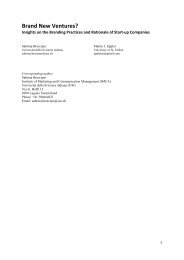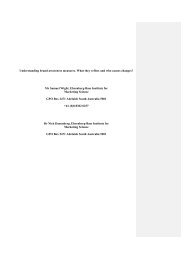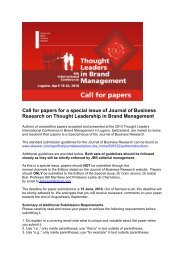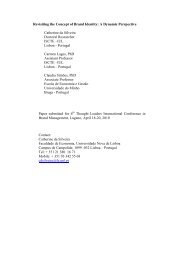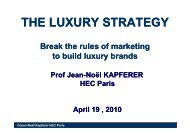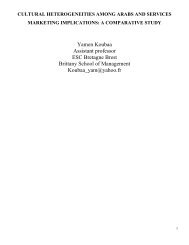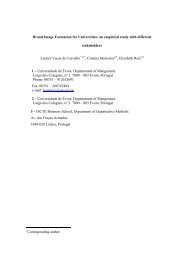Esch, Franz-Rudolf, Winter, Kai, Limited Editions
Esch, Franz-Rudolf, Winter, Kai, Limited Editions
Esch, Franz-Rudolf, Winter, Kai, Limited Editions
Create successful ePaper yourself
Turn your PDF publications into a flip-book with our unique Google optimized e-Paper software.
5and Mason, 2007). Within the scope of product categorisation, both assimilation- or contrasteffectscan be caused (Lee, 1995; Wänke et al., 2001). A contrast-effect usually occurs if astimulus related to a context-stimulus is categorised further away than in absence of thiscontext-stimulus. Assimilation describes the fact that a relation to a context stimulus increasesperceived similarity (Frey and Greif, 1994). Assimilation effects occur if a product issuccessfully identified as a member of a certain brand (Fiske and Neuberg, 1990; Schwarzand Bless, 1992). On the one hand, this implies a transfer of characteristics from the brand tothe product (Park et al., 1991; Reddy et al., 1994). On the other hand, characteristics of theproduct become a fundamental part of the brands’ mental representation and lead to a changeof the brands’ image (Loken et al., 1993; Romeo, 1991; Thorbjǿrnsen, 2005). For limitededitions it can be expected that they change the parent brands’ mental representation throughtheir characteristics, like for example the novelty, or their overall attractiveness in productcategories with a tendency to exploration.HYPOTHESESMeaning of exploration tendency for the effect of a product limitation: Concluding fromthe considerations about the impact of scarcity, consumers in the FMCG-sector use scarcitysignals as a heuristic cue to infer novel characteristics of the product. The perceived noveltyshould have a positive effect on product evaluation, especially in case of high explorationtendency. The following hypotheses can be derived from these conclusions:Hypothesis 1: Marking a product with an indication for limitation, increases perceivedproduct novelty.Hypothesis 2: Exploration seekers show a) a more positive attitude respectively b) a moredistinctive behavioural intention towards a limited product than exploration avoiders.Hypothesis 3: The scarcity effect appears only with exploration seekers. An indication forlimitation causes a) an increased product evaluation respectively b) a more distinctive behaviouralintention with exploration seekers. There is no positive impact on product evaluationand behavioural intention by limitation with exploration avoiders.Meaning of the depth of processing for the effect of a limited edition: Cialdini’s (1993)point of view that scarcity creates desire “at the push of a button” is only hard to apply for thelimited editions regarded in this article. It can be assumed that the effect of limited editions ismainly influenced by cognitive processes. The following hypotheses can be deduced:Hypothesis 4: A deeper processing of the limited edition leads a) to a positive attitudetowards the product, respectively b) to a stronger behavioural intention than a superficialprocessing.Hypothesis 5: The positive scarcity effect occurs with an atypically designed product only bydeeper processing. In this case, an indication of limitation leads to a) a more positive attitudetowards the product, respectively b) a stronger behavioural intention. There occurs no scarcityeffect with a low depth of processing.Reciprocal effects of the limited edition to the parent brand: The inclusion of the limitededition leads to a change of the mental brand representation. It can be assumed that there is apositive evaluation for limited editions in those FMCG-categories which tend to exploration.However, positive feedback effects on the overall-attitude can be expected only for weakbrands, because strong brands are assumed to already have a stable attitude (Keller and Aaker,1992). Moreover, the quality of novelty, which is associated with limited editions, leads to achanging attitude towards the brand. As in this case evaluations of a specific level aretouched, there is also a possibility of a change in judgement over a strong brand (Loken andRoedder John, 1993). The following hypotheses can be deduced:



